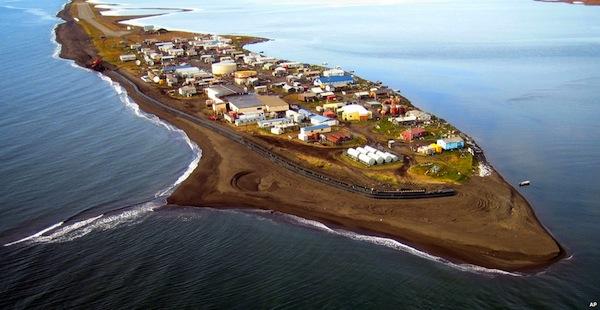Native Americans have long had a close relationship with their lands and waters—sacred places and resources that define their lives. The disruptions wrought by a warming climate are forcing abrupt cultural changes on peoples with a long reliance on a once stable ecosystem.
Among the special issues affecting tribes, the 2013 Assessment of Climate Change in the Southwestern United States (SWCA) cited “cultural and religious impacts, impacts to sustainable livelihoods, population emigration, and threats to the feasibility of living conditions.”
RELATED: Climate Change Hits Natives Hardest
The Hoh, Quinault, Quileute and Makah nations inhabit low-lying land along the west coast of Washington State, and face similar threats as rising sea levels and the other impacts of climate disruptions endanger their villages.
”The area is relatively vulnerable,” Patty Glick, senior global warming specialist and author of a 2007 National Wildlife Federation report, ”Sea Level Rise and Coastal Habitats in the Pacific Northwest,” told Indian Country Today Media Network in 2008. Higher wave action, wave force and destructive storm surges will increase in the coming decade, Glick said, and destructive storms such as the hurricanes will become more frequent.
RELATED: Olympic Coast Tribes Face Rising Ocean Levels
The Hoh road to the beach has washed out, and the ocean has destroyed the homes that once lined their beach. In Quinault, a passing storm tossed gigantic logs onto the school grounds. These events intensified both tribes’ agenda to get higher ground returned from the Olympic National Park beyond their tiny reservation boundaries.
The Makah and the Quinault nations have large reservations, but their seaside villages are at risk, as evidenced by the recent state of emergency at Quinault headquarters in Taholah, which faced an increasingly dangerous situation with sea level rise and intensified storms, which breached a sea wall causing serious damage.
According to Climate Central, which uses data from NOAA and the USGS, there is a greater than one in six chance that sea level rise, plus storm surge, plus tides, will raise sea levels by more than one foot before 2020 along the coastline and in the Puget Sound region, where another eight tribes are situated. The Shoalwater Bay sits nearly out to sea in southwest Washington.
Rising sea levels will affect Washington’s shoreline habitat for vegetation, animals, birds and fish, according to Glick’s report. Marshes, swamps and tidal flats will be significantly affected, and salmon and shellfish habitat are expected to be significantly affected, Glick reported.
Along Alaska’s northwestern coast, melting sea ice has reduced natural coastal protection. Increased coastal erosion is causing some shorelines to retreat at rates averaging tens of feet per year. In Shishmaref and Kivalina, Alaska, severe erosion has caused homes to collapse into the sea, according to the Environmental Protection Agency, forcing these Alaska Native Village populations to relocate in order to protect lives and property.
RELATED: Alaskan Native Communities Facing Climate-Induced Relocation
Moving inland, “Climate change is slowly tipping the balance in favor of more frequent, longer lasting, and more intense droughts,” states the SWCA. The Navajo Nation is experiencing annual average temperatures warmer than the 1904-2011 average, cites a climate report released in March 2014. Latest figures show their drought continuing beyond 2010 studies into July 2013, indicating the drought continues.
RELATED: New Report Aims to Help Navajo Nation Cope With Climate Change
Perhaps among the worst of those impacts are the runaway sand dunes it has unleashed, which extend over one-third the 27,000-square-mile reservation. During the 1996-2009 drought period the extent of dune fields increased by some 70%. These dunes are moving at rates of approximately 35 meters per year, covering houses, burying cars and snarling traffic, degrading grazing and agricultural lands, contributing to the loss of rare and endangered native plants, and when they occur contributing to poor air quality, a serious health concern for many of the reservation’s 173,667 residents.
RELATED: Climate Change, Drought Transforming Navajo’s Dunescape to a Dust Bowl
Intertribal organizations around the U.S. are recognizing climate change and variability as a significant factor that can impact tribal resources, livelihoods, and cultures, cites the latest tribal climate report. The National Tribal Air Association notes that “perhaps no other community of people has experienced the adverse impacts of climate change more than the nation’s Indian tribes.”
The struggle will soon come to more tribes. Sea level rise projections do not bode well and may already be a cause of concern for the tribes along Louisiana’s Gulf of Mexico—the United Houma Nation, the Atakapa-Ishak Nation, Pointe-au-Chien Tribe, and the Biloxi-Chitimacha’s Isle de Jean Charles Band, Grand Caillou/Dulac Band and Bayou Lafourche Band. In Florida—the Miccosukee, and some locations of the Seminole Indian Reservations. Ocean residing tribal nations in California include the Agua Caliente Band of Cahuilla, Cahto, Chumash, Hoopa, Karok, Kumeyaay, Luiseño Bands of Indians, Maidu, Miwok, and some bands of the Pomo Nation. Some are more at risk than others.
RELATED: 6 Tribal Nations Taking a Direct Hit From Extreme Weather
Read more at http://indiancountrytodaymedianetwork.com/2014/05/07/climate-disruptions-hitting-more-and-more-tribal-nations-154747?page=0%2C1

